Mezquita – Cordoba’s Incredible Grand Mosque
When we decided to visit Andalusia last November one of the key reasons was to visit the Alhambra in Granada. After the visit I wrote in this post that it was pretty strange that the best preserved Islamic palace in the world was in a purportedly Christian country. What I didn’t know when I wrote that post is that Spain might also be home to the most interesting mosque in the world as well – the Mezquita or Grand Mosque of Cordoba. BTW Mezquita, according to Rick Steves, is pronounced like a female mosquito. Won’t you join Alison and me as we tour this amazing building along with the adjoining bell tower and alameda?
We first got a look at the exterior of the Mezquita on our morning walking tour of Cordoba. Here is what it looks like from the opposite bank of the Guadalquivir River.
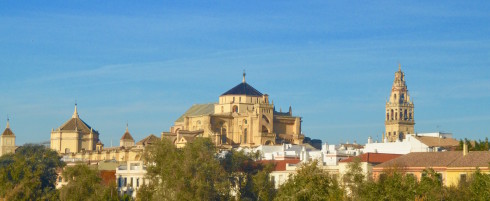
Okay, I know what you’re thinking, “That doesn’t look like a mosque me. This is what a mosque looks like.”
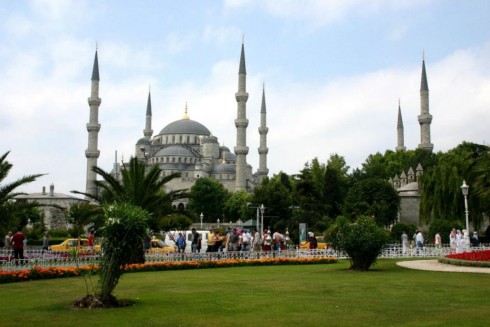
You’d be quite right on that score. The Mezquita today is actually the Cathedral of Our Lady of Assumption and hasn’t been a mosque for over 780 years. Here’s the reason why.
History of the Mezquita
The Moors conquered the then Visigoth city of Cordoba in 711 and started construction of the Mezquita over the site of the former St. Vincent Basilica in 786. It seems that both conquering Christians and Muslims liked to put their stamp on a newly conquered territory by building a church or mosque on the site of the previous religion’s most important place of worship. As noted in my previous post on Cordoba, it grew to be the largest city in Europe under Moorish rule and the centre of Islamic culture in Spain. As such it needed to have a mosque that could hold increasingly large numbers of worshippers. The first Mezquita held up to 5,000 of the faithful, but subsequent expansions allowed for 9,000 then 15,000 then 23,000 and finally an incredible 40,000 people could fit under the one roof. That was its size when the Christians reconquered Cordoba in 1236.
It wasn’t until the 1500’s that Charles V gave permission to build a Christian church smack dab in the middle of the Mezquita. He is said later to have regretted ruining the finest building in his kingdom. I’ll reserve judgment until I see it in person.
While the exterior of the Mezquita is nothing exceptional and certainly can’t hold a candle to the Blue Mosque of Istanbul, it is the interior that can literally make a visitor dumbstruck. Inside there are over 800 marble, jasper and granite columns that hold up over 400 arches. Here is a floor plan. The dark object in the upper right corner is the bell tower, the green area is the alameda and the rest is the interior, showing the various expansions in different colours. The cathedral is in the very centre.
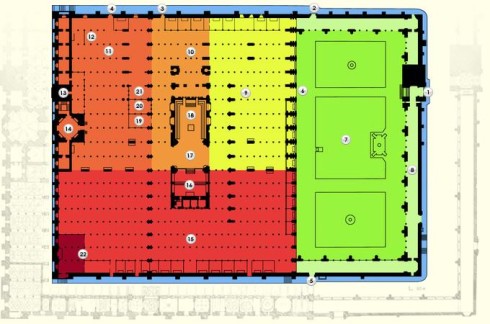
The Bell Tower
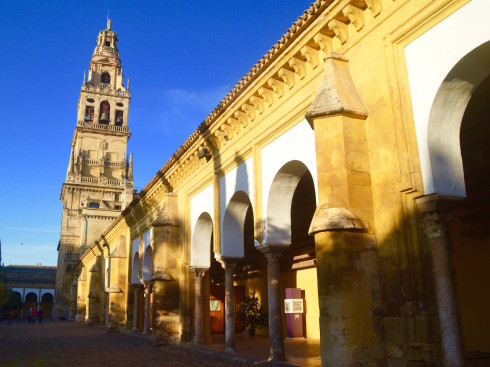
I’ve never seen a bell tower I didn’t want to climb and the Mezquita’s is no exception. We want to start here so we can get a good look at the Mezquita from above and try to understand the relationship between the mosque and the cathedral. There is a separate entry fee for the bell tower of 2€. If you were a real idiot or just a cheapskate you could settle for just looking at the Mezquita from the top and save the 11€ entry fee.
The bell tower completely encases the original minaret built around 950. Where the muezzins once called the faithful to prayer five times a day, there are now bells that are still rung every hour or more. As bell towers go, this climb is not so bad and the view is fantastic. In this photo you can see our hotel, the Balcon de Cordoba amidst the cluster of old city buildings below. That’s the roof top patio and bar in the middle.
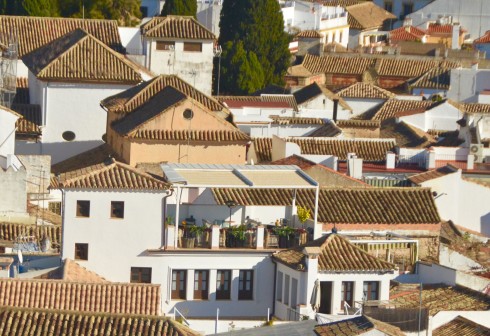
Here’s a view of the old city proper. Not as nice as the view from the Alcazar in the Alhambra, but pretty interesting nonetheless.
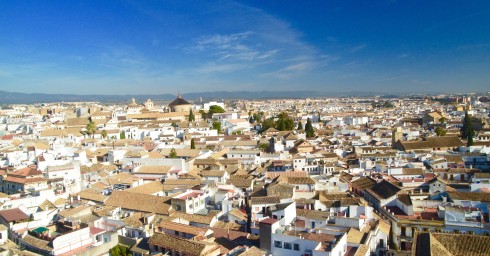
Here’s our proof that we did actually climb the tower and not just crib these pictures from another site.
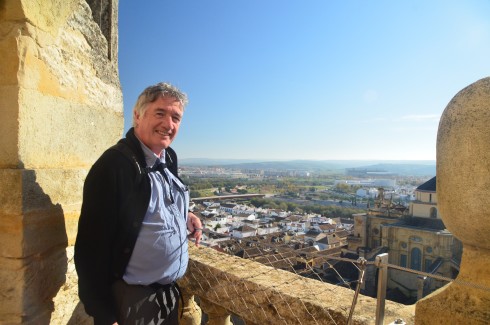
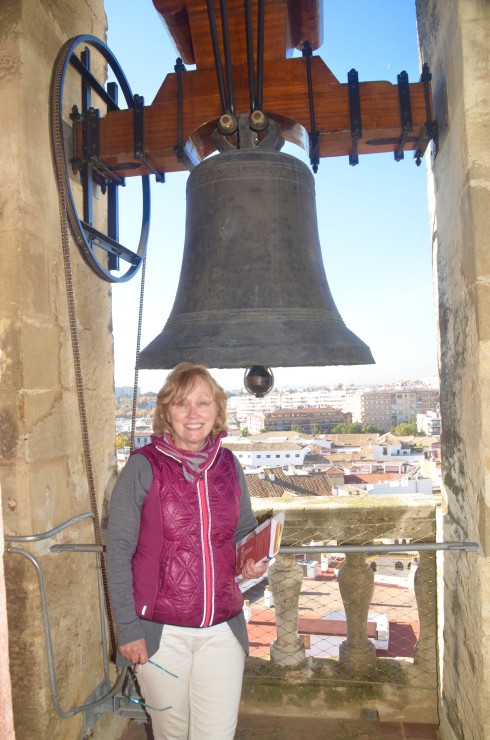
I think Alison would still be deaf if the bell had gone off.
Here’s the Alameda or Orange Tree Courtyard as it is also called. Very pretty from above and as you can see there are not that many people around.
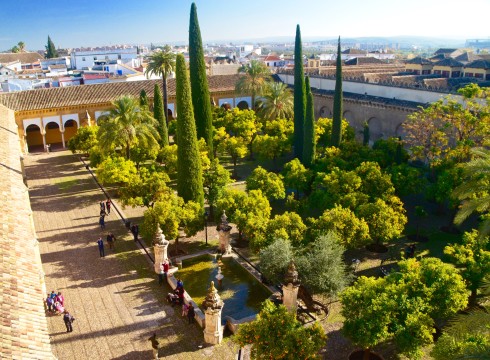
And finally, the view you’ve all been waiting for – The Mezquita.
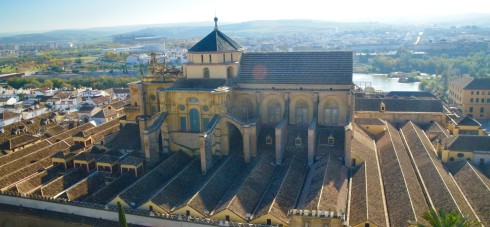
Only from this view can you appreciate that the original mosque was comprised of a number of v-shaped roofs and was not very high. How they managed to put that great pile of stone that is the cathedral in the middle of it all without completely destroying the mosque is beyond my ken. This must be the only building in the world where you can simultaneously compare Islamic and Christian visions of what a house of worship should look like. While the exterior of the cathedral would not by any means be considered great, it does demonstrate the contrast between the two concepts. Christians literally wanted to go up as high as possible towards the heaven that they believed existed above the earth. Muslims believed, to a certain extent, that less is more.
Okay time to go inside and continue our study in contrasts.
Interior of the Mezquita
The entry fee to the Mezquita proper is now 11 € and includes an audio guide and a map with the various points of interest. It is important to keep the map because there is virtually nothing inside indicating what’s what. Even with the audioguide I managed at one point to get completely disoriented and it took me fifteen minutes to get back on track. At one point on the audio tour I realized that what I was seeing was not matched with what I was hearing.
In my post on the Alhambra I recommended not taking a guided tour for reasons you can read for yourself. Here it’s the opposite. The place is so huge that even with a dozen guided tours underway it does not feel crowded, after all it could hold 40,000 people. Guided tours of ten or more are required to use a voice transmitter and still being a place of worship, everyone is required to keep their voices down. So it’s a really quiet place.
Cameras and flashes are allowed, but not tripods. Also, proper dress is required so those in a state of undress will not be admitted.
Now I’ve seen pictures of the famous columns and arches of the Mezquita many times, but honestly, nothing can prepare you for seeing them in person. Earlier I used the word dumbstruck and it’s not hyperbole in the case of this place. The entrance takes you into the original and oldest part of the mosque and you can tour the building counter-clockwise to go through all the expansions in chronological order. Strangely enough, it’s so big that you don’t even really notice the fact that there is this huge church in the middle of it all.
The Mosque
I am going to show you pictures of the mosque first and then the cathedral and you can come to your own conclusions. We didn’t see a lot of people in the alameda and it doesn’t seem like there are many here either. Here are some pictures of us with almost nobody else in them. Try doing that in Westminster Abbey or Notre Dame before it burned, at any time of year.
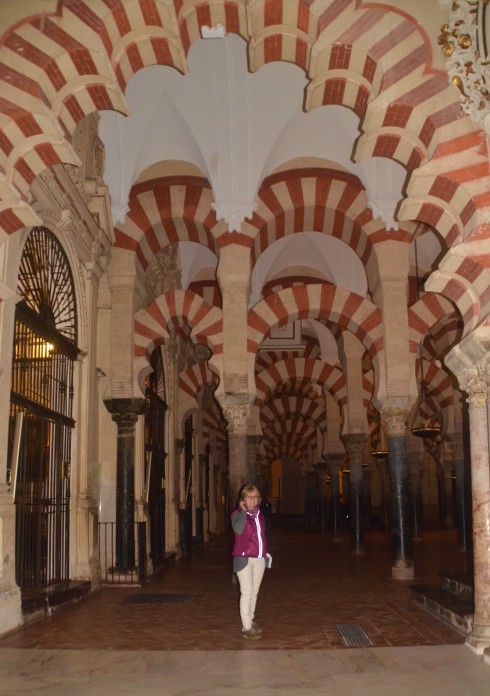
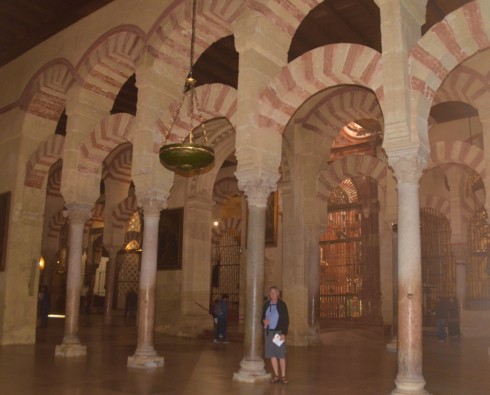
Trying to describe the beauty and simplicity of the mosque is hopeless. Just enjoy the pictures.
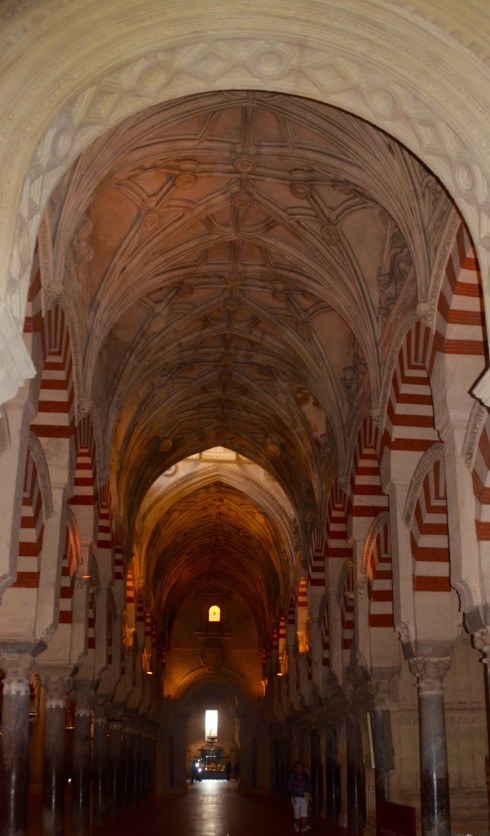
These double columns are masterful.
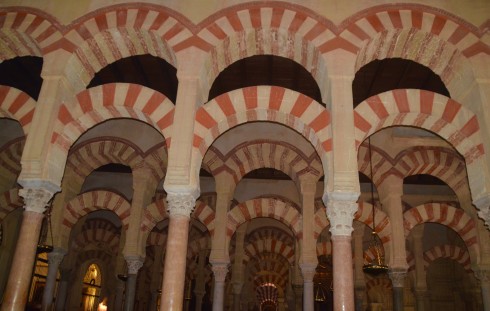
There are a few Christian symbols, like this crucifixion, in the mosque part, but not so many that they detract from the original design.
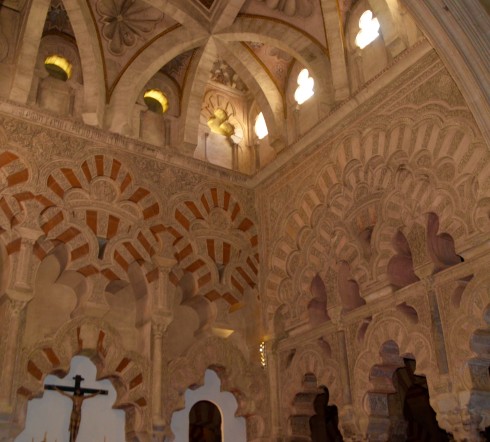
Every pillar is unique. I suspect that more than one was first erected in Roman times.
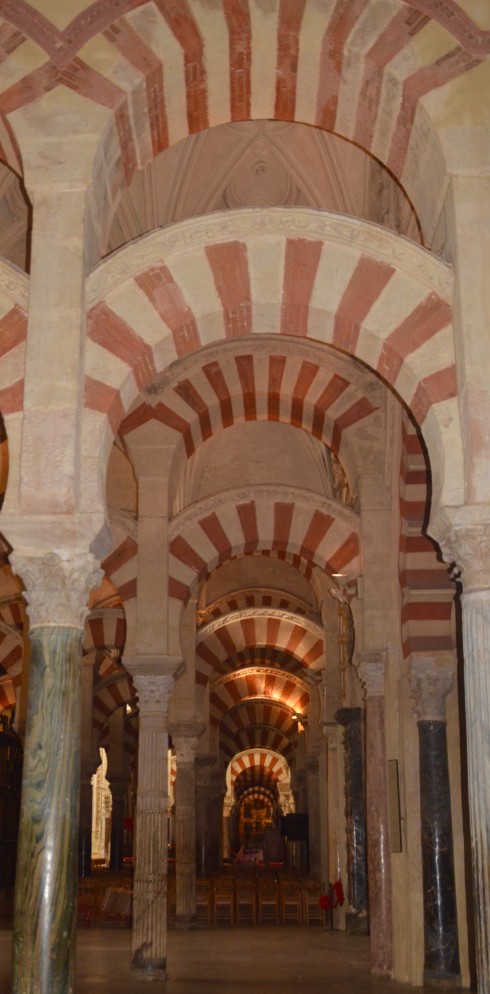
Even without the colour it looks amazing.
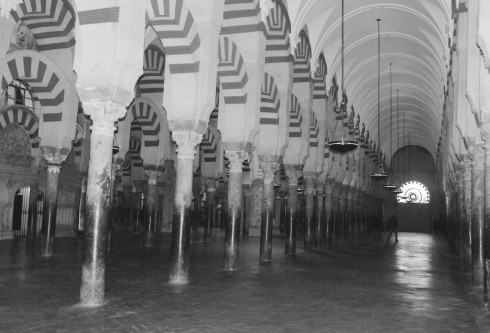
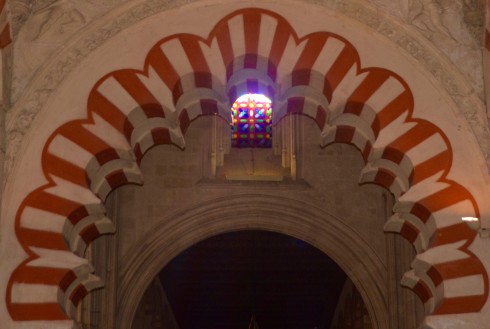
And then you come to the holiest place in the mosque, the mihrab, which identifies the direction of Mecca and thus the direction to pray in.
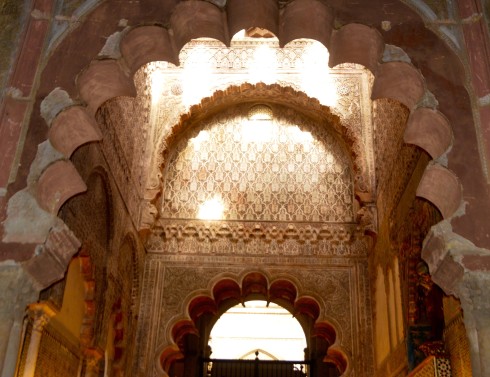
The Cathedral
As I noted earlier, the cathedral doesn’t really interfere with the integrity of the mosque (except obviously where it has replaced it). In a mosque the most important part is the front where the mihrab is, so plunking a church in the middle of the mosque is not as bad as it could be i.e. destroying the entire mosque and replacing it with a church.
From the very first of the reconquest the Christians knew and appreciated that the Mezquita was something special and left it intact for hundreds of years. Finally the zealots got to Charles V and he gave permission to build the present day cathedral. This is what they built.
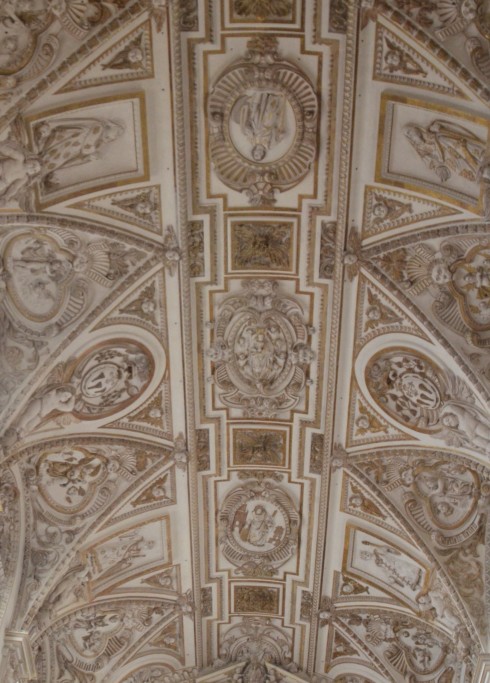
While the arches and columns of the mosque keep your eyes focused pretty well at ground level and you hardly notice the ceiling, in the cathedral the ceiling is all important.
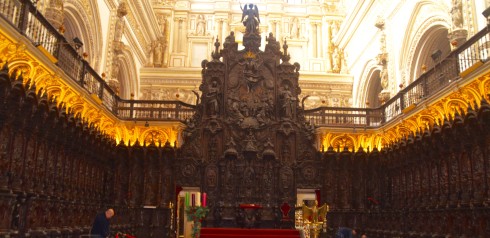
Music and song are integral elements of most Christian sects, while Muslims have recitation. The carvings in this choristry are amazing for their detail and each tells a unique story.
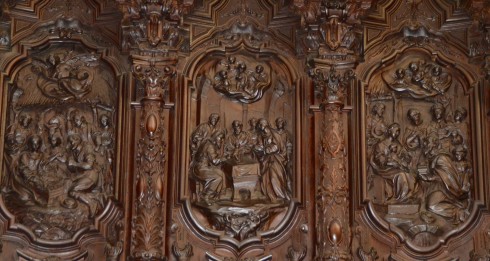
And of course, all Catholic churches are replete with representations of Jesus, the saints and even God himself. In Spain they have fantastically well carved wooden statues of the saints. Such representations are absolutely forbidden to Muslims and breaking the taboo can have serious consequences, even to non-Muslims. Just ask the folks at Charlie Hebdo.
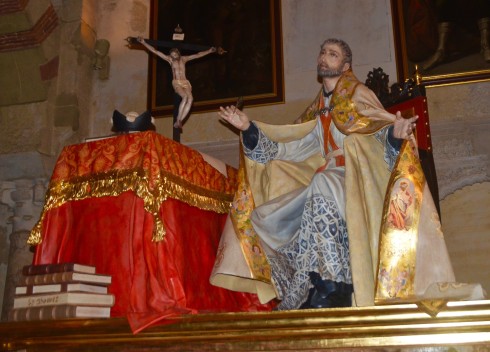
One thing both Catholics and Muslims are equally deluded about is the reverence for relics. I once saw an old pot in the Topkapi Palace that allegedly belonged to Abraham and an at least size 30 footprint that was said be made by Muhammed himself.
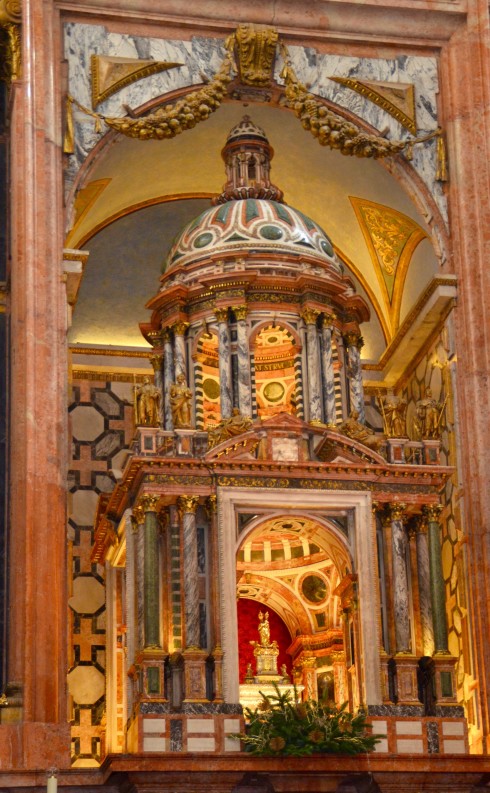
There is a million things I could say about the contrasting styles found in the Mezquita and what they represent, but since I don’t believe in any of it, why bother commenting. My opinion on the matter means nothing. I do know that the mosque portion of this building is among the most beautiful in the world and worth seeing whether you are a Christian, Muslim, agnostic or atheist. Man has actually done a few good things in the name of religion and this is one of them.
As we leave through the alameda I look up and see a faint crescent moon beside the bell tower. Maybe it’s an omen of better days to come in the relationship between Christians and Muslims. I sure as hell hope so.
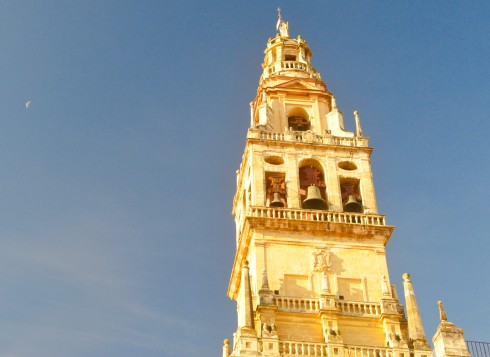
Oh, and Charles, you were right.

